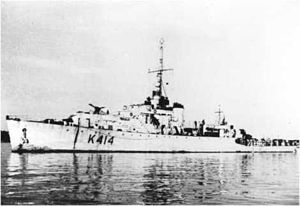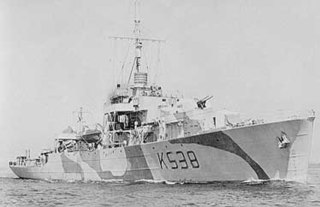
HMCS Toronto was a River-class frigate that served in the Royal Canadian Navy during the Second World War and as a Prestonian-class frigate from 1953-1956. She was named for Toronto, Ontario. She was later acquired by the Royal Norwegian Navy and renamed Garm and then again in 1965 as HNoMS Valkyrien.

HMCS Cap de la Madeleine was a River-class frigate that served in the Royal Canadian Navy from 1944-1945 and as a Prestonian-class frigate from 1954-1965. She saw action in the Battle of the Atlantic as a convoy escort during the Second World War. She is named for Cap-de-la-Madeleine, Quebec, which is now a part of Trois-Rivières.
HMCS Fort Erie was a River-class frigate that served in the Royal Canadian Navy during the Second World War and as a Prestonian-class frigate from 1956-1965. She was named for Fort Erie, Ontario.

HMCS Penetang was a River-class frigate that served in the Royal Canadian Navy from 1944 to 1945 during the Second World War. She fought in the Battle of the Atlantic as a convoy escort. She was recommissioned and served as a Prestonian-class frigate from 1954 to 1956. She was named for Penetanguishene, Ontario.

HMCS Charlottetown was a River-class frigate that served with the Royal Canadian Navy (RCN) during the Second World War. She was the second vessel of the name, HMCS Charlottetown having been a Flower-class corvette that had been sunk earlier in the war. They are unique for being the only two ships to have shared the same pennant number, K 244. She was named for Charlottetown, Prince Edward Island.
HMCS Lauzon was a River-class frigate that served with the Royal Canadian Navy during the Second World War and again as a Prestonian-class frigate from 1953-1963. During the war she served primarily as an ocean escort for convoys. She was named for Lauzon, Quebec.

HMCS Cape Breton was a River-class frigate that served the Royal Canadian Navy (RCN) during the Second World War. She served primarily as a convoy escort in the Battle of the Atlantic during the war. She was named for Cape Breton Island in Nova Scotia. She was the first to carry her name, HMCS Cape Breton was the second.
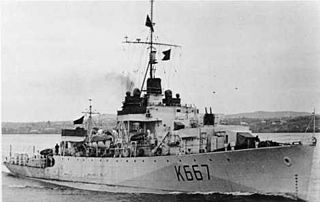
HMCS Inch Arran was a River-class frigate that served with the Royal Canadian Navy during the Second World War and again from 1954 to 1965, when she was converted into a Prestonian-class frigate. She was named after Inch Arran Point in Dalhousie, New Brunswick, Canada. This was due to the inability of two Allied warships to bear the same name. The RCN would then use landmarks or significant areas that were associated with the community instead.
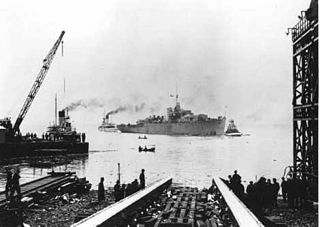
HMCS Prestonian was a River-class frigate that served with the Royal Canadian Navy during the Second World War and as a Prestonian-class frigate from 1953–1956. She saw action primarily as a convoy escort. She was named for Preston, Ontario, however due to possible confusion with HMS Preston, her name was altered. In 1956 she began service with the Royal Norwegian Navy as Troll.
HMCS Buckingham was a River-class frigate that served with the Royal Canadian Navy during the Second World War and as a Prestonian-class frigate from 1954–1965. She was named for Buckingham, Quebec. She is considered a significant part of Canadian naval history as used for some early trials of helicopter landings on smaller escort vessels. This led to the development of the future helicopter carrying destroyers.

HMCS Capilano was a River-class frigate that served with the Royal Canadian Navy during the Second World War. She served primarily as a convoy escort in the Battle of the Atlantic. She is named for the Capilino River in North Vancouver, British Columbia. The navy intended to name the ship after North Vancouver; however, due to possible confusion with HMCS Vancouver, she was named after the lake.
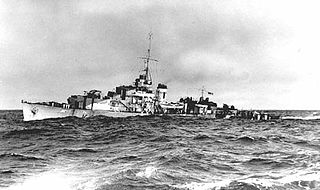
HMCS Coaticook was a River-class frigate that served with the Royal Canadian Navy during the Second World War. She fought primarily in the Battle of the Atlantic as a coastal convoy escort. She was named for Coaticook, Quebec.

HMCS Joliette was a River-class frigate that served with the Royal Canadian Navy during the Second World War. She served primarily as a convoy escort in the Battle of the Atlantic. She was named for Joliette, Quebec. After the war she was transferred to the Chilean Navy in 1946 and renamed Iquique. She served with the Chilean Navy until 1968.

HMCS Jonquière was a River-class frigate that served with the Royal Canadian Navy during the Second World War and again from 1954–1966 as a Prestonian-class frigate. She was named for Jonquière, Quebec.

HMCS Valleyfield was a River-class frigate that served with the Royal Canadian Navy during the Second World War. She served primarily as a convoy escort in the Battle of the Atlantic. She was torpedoed and sunk in May 1944, the only River-class frigate lost by the RCN. She was named for Salaberry-de-Valleyfield, Quebec.

HMCS LaSalle was a River-class frigate that served with the Royal Canadian Navy during the Second World War. She served primarily as a convoy escort in the Battle of the Atlantic and in the Battle of the St. Lawrence. She was named for LaSalle, Quebec.

HMCS Lévis was a River-class frigate that served with the Royal Canadian Navy during the Second World War. She served primarily as a convoy escort in the Battle of the St. Lawrence and the Battle of the Atlantic. She was the second ship to bear the name of Lévis, the first being a Flower-class corvette that had been sunk earlier in the war. She was named for Lévis, Quebec.
HMCS Sea Cliff was a River-class frigate that served with the Royal Canadian Navy during the Second World War. She served primarily as a convoy escort in the Battle of the Atlantic. She was named for Leamington, Ontario, but due to possible confusion with HMS Leamington, she was given a name associated with the town. Following the war, she was sold to the Chilean Navy and renamed Covadonga.

HMCS St. Pierre was a River-class frigate that served with the Royal Canadian Navy during the Second World War. She saw action as a convoy escort during the Battle of the Atlantic. She was named for Havre-Saint-Pierre, Quebec, whose name was shortened due to its length. After the war she was sold to Peru and renamed Teniente Palacios in 1947.

HMCS Victoriaville was a River-class frigate that served with the Royal Canadian Navy during the Second World War. She served primarily as a convoy escort in the Battle of the Atlantic. She was named for Victoriaville, Quebec. After the war she was converted to a Prestonian-class frigate in 1959. In 1966 she was converted to a diving tender and renamed Granby, serving as such until 1973 when she was decommissioned for the final time.
